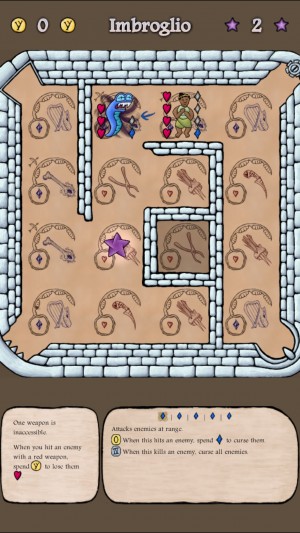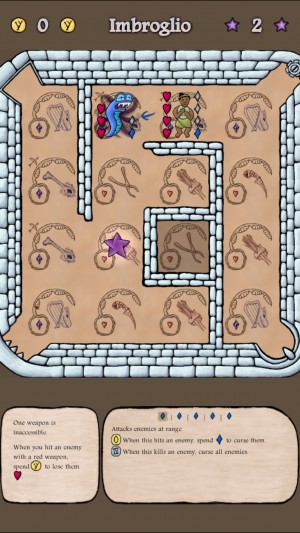 There are two things I know when I fire up a new game from Michael Brough. One, its presentation is probably not going to win any awards. Two, I’m going to have a good time. Brough’s got a talent for designing games whose gracefully skate the line between accessibility and depth. 868-HACK ($7.99) is the kind of game that should probably be on everyone’s mobile device. I’m sure it isn’t, but it ought to be. His latest game is Imbroglio ($3.99), and while it’s clearly another spin on the single-screen strategy trappings that comprise many of Brough’s offerings, it is a clever one. It has a similar appeal to 868-HACK, but throws in a few interesting twists for your brain to chew on.
There are two things I know when I fire up a new game from Michael Brough. One, its presentation is probably not going to win any awards. Two, I’m going to have a good time. Brough’s got a talent for designing games whose gracefully skate the line between accessibility and depth. 868-HACK ($7.99) is the kind of game that should probably be on everyone’s mobile device. I’m sure it isn’t, but it ought to be. His latest game is Imbroglio ($3.99), and while it’s clearly another spin on the single-screen strategy trappings that comprise many of Brough’s offerings, it is a clever one. It has a similar appeal to 868-HACK, but throws in a few interesting twists for your brain to chew on.
In Imbroglio, you take one of several characters into a dungeon. There are doors in the corners that will occasionally let a monster in, and you’ll obviously want to watch out for those. The goal is to collect the purple star that appears, at which point the walls of the dungeon will be reset, you’ll regain a point or two of damage, and the star will relocate to another spot. You need to gather as many stars as possible before your inevitable death. Besides the ever-changing walls, the main gimmick is that your attacks and skills are determined by where your character is standing. Each space on the dungeon board has a piece of gear attached to it that you can use to fend off the monsters. As you kill enemies, the gear on the squares will level up, with various effects. You’ll also earn runes that allow you to use your character’s special ability.
 The gear pieces come in two general types, physical and magical, each dealing damage to either life points or magic points. Every entity in the game, including yourself, has a quantity of both types of points. If either of the two is completely depleted, it means death. It’s in your best interests, then, to make sure you’re attacking each monster’s weakest point. If a beast has four life points and only one magic point, you’d best head over to a square with magic gear. Some gear gets better with use, while other pieces degrade. Some have unpredictable effects. A few work at long range, but most require the target to be in an adjacent square. Since the monsters get to make a move for every turn you take, you can’t always get to the best square on the board for the situation at hand, and instead have to make do with what’s nearby.
The gear pieces come in two general types, physical and magical, each dealing damage to either life points or magic points. Every entity in the game, including yourself, has a quantity of both types of points. If either of the two is completely depleted, it means death. It’s in your best interests, then, to make sure you’re attacking each monster’s weakest point. If a beast has four life points and only one magic point, you’d best head over to a square with magic gear. Some gear gets better with use, while other pieces degrade. Some have unpredictable effects. A few work at long range, but most require the target to be in an adjacent square. Since the monsters get to make a move for every turn you take, you can’t always get to the best square on the board for the situation at hand, and instead have to make do with what’s nearby.
As you play, the types of monsters unleashed get stronger, so while it might seem like you can just flit about and use whatever happens to be in front of you, that strategy will only take you so far. If you want to rack up a high score, you need to plan from the start which gear pieces you want to focus on leveling, and do your best to stick to that. The strength and quantity of the numbers will outpace your own growth if you don’t pay attention. Naturally, each character requires a slightly different approach as well. The obvious difference between them is the board layouts they start with, but you’ll soon get the ability to customize those. It’s more a case of which gear pieces they can choose from and how their special abilities work that separates them. One character is nicely balanced and can heal, but has no access to ranged weapons. Another can throw curses on enemies, but doesn’t recover as much as other characters when she picks up purple stars.
You’ll start off with a selection of four different characters, with the remaining four unlocking when you reach certain high scores. The first unlockable for each character is the one that allows you customize the board, an important feature that you should take advantage of in order to reach higher scores. While connecting characters to unlockables could have resulted in an unfair competition between haves and have-nots, Imbroglio avoids this problem by separating scores and leaderboards by characters. You don’t have to try to compete with your Count Harry against someone’s Nomad Witch. Instead, you compete against everyone else’s Harry. Even if you’re not interested in leaderboard competition, the game nicely tracks your high scores with each character individually, letting you know your previous best and whether or not you’ve beaten it.
 The controls are similar to those in 868-HACK. You swipe in any direction to move one space up, down, left, or right. If you can attack an enemy, swiping towards them will do that. If your character’s special ability is manual, simply hit the button on the status display whenever you want to use it. Holding your finger on a square or enemy will give you details about their behaviors. That’s really all there is to it. One big difference from 868-HACK is that Imbroglio is only playable in portrait mode. I know some readers aren’t fans of games that do that, but it works quite well here. It’s a nice game to play when you only have one hand free. It’s still not much of a looker, and the audio is more or less limited to a bit of acoustic guitar when you attack an enemy, but it gets the job done.
The controls are similar to those in 868-HACK. You swipe in any direction to move one space up, down, left, or right. If you can attack an enemy, swiping towards them will do that. If your character’s special ability is manual, simply hit the button on the status display whenever you want to use it. Holding your finger on a square or enemy will give you details about their behaviors. That’s really all there is to it. One big difference from 868-HACK is that Imbroglio is only playable in portrait mode. I know some readers aren’t fans of games that do that, but it works quite well here. It’s a nice game to play when you only have one hand free. It’s still not much of a looker, and the audio is more or less limited to a bit of acoustic guitar when you attack an enemy, but it gets the job done.
While it takes a few minutes to learn the idiosyncrasies of Imbroglio, it’s a highly approachable game. Wisely, the game locks the board-building aspect at the start of the game. It’s not a high hurdle to get over by any means, but it’s just high enough that you’ll have the basics of the game understood before it throws that extra complication at you. The unlockable characters give you extra goals to shoot for while also layering in some extra replay value down the road. The moment-to-moment gameplay keeps choices to a minimum, but the overall level of strategy both in building your board and setting up your overall plan for each session offers a highly satisfying amount of depth. My main complaint is a usual one for games of this type: once you’ve got the hang of the gameplay, the initial ramp-up drags on a little too long and can get dull.
Some players who have spent a long time with any of Michael Brough’s other games might find Imbroglio to be somewhat derivative, but I feel like it does a reasonably good job of distinguishing itself without venturing too far from what has worked so well in the past. If you’ve enjoyed any of Brough’s other works, or simply want an easy to pick up, moderately deep strategy game, Imbroglio is an easy recommendation. I’m not sure if I like it better than 868-HACK, but it’s more than worthy enough to sit beside it.